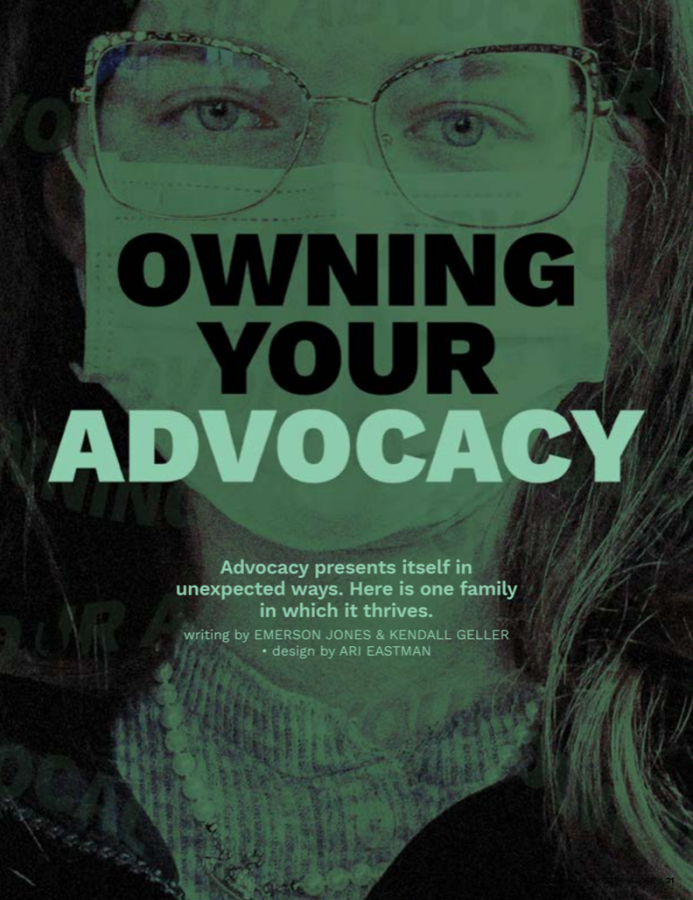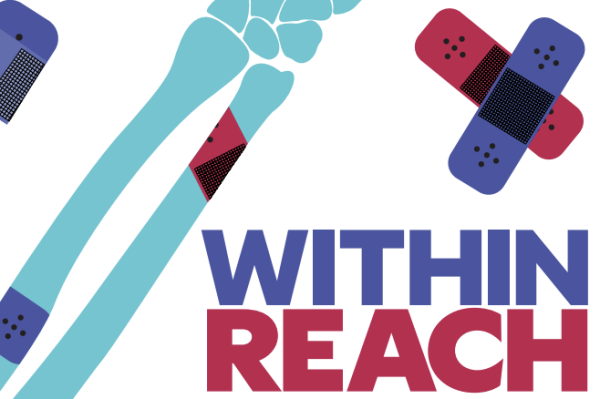Owning Your Advocacy
Advocacy presents itself in unexpected ways. Here is one family in which it has taken root.
First, they said that her backpack was too heavy. But the weight of her backpack didn’t explain the trouble swallowing. Or the back pain. Or the dizziness. Or the numbness. Or the memory loss.
Macy Paradis, a 21-year-old student at Georgetown College, had been experiencing random health issues for as long as she could remember. She had trouble swallowing since the fifth grade, which caused her to choke multiple times per day. She had tingling and numbness in her limbs. Sometimes, she couldn’t feel her arms or legs at school and would have to be wheeled from class to class. Then there was the back pain. And the extreme migraines. And the severe dizziness. Plus, there was the time when she blacked out at school and forgot where she was.
The supposed causes of these symptoms varied from expert to expert. One doctor told her that her back pain was caused by the heaviness of her backpack. Another doctor told her that she had a spinal fracture. Another boiled it down to a sprain in her neck. Macy, who was just 13 at the time, knew the doctors were wrong, but her instincts meant nothing in the face of their cluelessness.
“I was so aggravated. I was like, ‘You’re not listening to me.’ So, I forced him to order me an MRI,” Macy said.
Reluctantly, her doctor agreed.
Days later, Macy left school early after her arms and legs went numb, which prevented her from walking properly. Her memory was a bit foggy, but she remembered a phone call from the doctor to her mother.
The doctor told her that she wasn’t coming back to his office. He said that she was going to see a neurosurgeon because of a rare brain condition called chiari malformation.
The concerns of many 13-yearolds revolve around sports, school, and friends. Macy strayed far from these typical teenage standards. While facing her symptoms and pushing for answers, she developed the maturity and drive of those much older than her in order to reach a diagnosis.
Chiari malformation is a condition in which the brain tissue extends into the spinal cord. Put simply, her cerebellum was falling out of her skull.
“Or, as I like to say, I’m just so smart that my brain got too big and didn’t fit anymore,” Macy said.
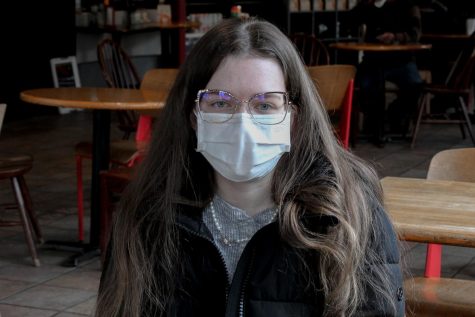
On Friday, March 25 at Heine Brothers, Macy Paradis, 20, recalls urging her doctors to address her health concerns, until she was ultimately diagnosed with Chiari malformation. Photo by Erica Fields. (Photos by Erica Fields)
The cerebellum, which is the back portion of the brain, controls balance, movement, and coordination. Macy also found out that she had a condition called syringomyelia, which causes cysts full of spinal fluid to form on the spinal cord.
After years of worsening symptoms, Macy finally received answers. Her constant back pain was caused by the cysts that would rub against her spinal cord every time she moved. Since the cerebellum protruded into the cavity where the brain stem was supposed to connect to the spine, the flow of spinal fluid into the brain was blocked and it was being compressed. The constriction of her brain caused her numbness and random tingling, as well as the instances in which she would black out.
Macy received her diagnosis in February 2015. Then, in March of the same year, she had brain surgery. Specifically, chiari decompression surgery. During surgery, her surgeon removed a piece of her skull to widen the hole at the base, which would allow the flow of spinal fluid and relieve the pressure on her brain.
Macy still isn’t sure how long she has had chiari malformation or what may have caused it. Her symptoms progressed quickly, but it is possible that they had been building up for years. Some known causes of chiari malformation include traumatic birth and whiplash from car accidents — both of which happened to Macy.
Although there are several known causes of chiari malformation, there is very limited research on it. Located in Akron, Ohio, the Conquer Chiari Research Center (CCRC) works to provide thorough and relevant information on chiari malformation, as well as spread awareness and fund more research. With their findings, they hope to provide insight to those in the medical field in order to reduce false diagnoses and treatments.
Macy has had the opportunity to contribute a sample of her saliva to a study conducted by the CCRC called Chiari 1000. In this study, researchers looked into the genetics of chiari malformation and aimed to create a set of data on chiari patients as a whole. Along with participating in the CCRC’s study, Macy spreads awareness about chiari malformation on her own time. She has a Facebook page called Macy’s Purple Brains in which she posts information about chiari in order to educate her followers. Plus, for Macy’s 21st birthday, she asked people to donate $21 to the CCRC instead of buying her a drink. She also posts updates on chiari research and her own journey regarding living with chiari and life after surgery. However, the CCRC remains one of the only chiari malformation research centers in the nation. The solitude of the research center provokes frustration in Macy. Some of this frustration stems from within her own family. Macy’s sister, 14-year-old Mallory Paradis, has a progressive genetic condition called cystic fibrosis (CF). CF damages the digestive and respiratory systems, which often results in sticky, thick mucus building up in various organs and areas in the body. For Mallory, her sinuses are the most affected by her CF.
“My sister has a condition that does get worldwide recognition, and then, mine – it’s just this little tiny center in Akron, Ohio,” Macy said.
Macy and Mallory have a unique relationship, partly because they are remarkably different people. These differences sometimes make it hard for the sisters to communicate effectively.
Because Mallory has been diagnosed with a learning disability, it is sometimes hard for the girls to see where the other is coming from. Despite their differences, Macy and Mallory have a strong sisterly relationship. The two have become closer with age. They also are able to relate to each other more, both having gone through life-changing situations that the average person hasn’t had to endure.
“My sister and I have always been the sick kids,” Macy said.
Even though chiari malformation and CF are extremely different, a symptom of both diseases are headaches. Mallory gets sinus headaches from CF, and Macy gets what are called chiari headaches.
“When I get really bad headaches and when she gets really bad headaches, we’re like, ‘Bad headache? Yeah. Been there before. I know now how that feels,’” Mallory said.
Up until her diagnosis at age nine, Mallory spent years suffering from sinus-related issues. She was constantly out of school because she was sick, but her pediatrician claimed that the root of her problems were a combination of asthma and her sinuses. However, that didn’t sit right with her mom.
“I kept saying, ‘There’s something else wrong,’” Nancy said. “Why would she be this sick all the time with just a combination of asthma and her sinuses?”
Because of the immense discomfort Mallory experienced, she visited an ear, nose, and throat physician (ENT) to check on her sinuses. The ENT who conducted the sinus surgery prior to her diagnosis was the first to acknowledge the extent of the damage to Mallory’s sinuses.
“Her very first sinus surgery, which he thought would take 45 minutes, took three hours,” Nancy said.
Mallory only got more sick from there. Nancy and Mallory were frequent visitors to the ER. During one visit, Mallory was told that she needed to be admitted to the Norton Women’s and Children’s Hospital. At Norton, Mallory was put through numerous procedures, including tests for infectious diseases, an MRI, and a bronchoscopy.
“They just kept saying, ‘She’s a really, really sick little girl, we have to find out what’s wrong with her,’” Nancy said, her voice breaking and eyes welling up with tears.
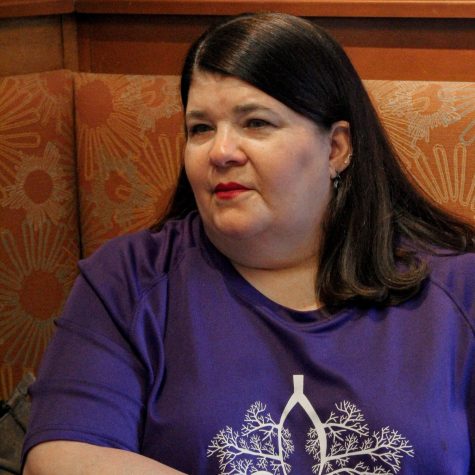
At Panera Bread on Friday, April 15, Nancy Paradis explains the devices needed to combat Mallory’s cystic fibrosis, such as an acapella, or “green pickle,” a device used to shake the lungs in order to help remove mucus from the airways. Photo by Erica Fields. (Photos by Erica Fields)
Finally, the doctors tested Mallory for cystic fibrosis, and years of wondering came to an end. With a clear diagnosis, Mallory began taking medication and seeing specialized doctors.
“Once I got the medication I needed, it got better,” Mallory said.
While neither CF nor chiari malformation have a cure, CF has several medications and devices to treat the symptoms. Sometimes, when Mallory is stubborn and fights her medication, Macy can be hard on her, pushing her to take advantage of the resources that Macy never had.
“It hurts me a little because I don’t have medications to take,” Macy said.
However, Macy doesn’t let her frustration deter her from advocating for CF. She works with the Cystic Fibrosis Foundation, a non-profit organization dedicated to providing the means to find a cure for CF while aiding those with CF across the country. They sponsor the largest CF fundraiser in the country, the Great Strides Walk. The Great Strides Walk for the Kentucky and Virginia chapter of the CF Foundation is held annually at Louisville Slugger Field. Macy and her family participated in the walk once before, but for the past two years, the Great Strides Walk hasn’t occurred because of COVID-19. However, Macy is hopeful that there will be a Great Strides Walk this year.
Various obstacles limit Mallory’s involvement in CF activism. She is not very interested in social media, which removes a major outlet of advocacy. Additionally, Mallory isn’t able to be physically present at advocacy events. People with CF have to stay at least six feet in distance from each other. When they get in close proximity, there is the potential for cross-infection of harmful bacteria, which could cause their condition to deteriorate at a faster pace. Because of this, there is usually only one person with CF allowed to be in attendance at many events with CF organizations.

At Panera Bread on Friday, April 15, Nancy and Mallory Paradis discuss their support for the Cystic Fibrosis Foundation, whose mission is to provide individuals with cystic fibrosis with the opportunity to live long, fulfilling lives. Photo by Erica Fields. (Photos by Erica Fields)
However, Mallory was the chosen honoree for Cure CF Louisville’s 2021 CRAFT Beer and Pizza festival, a yearly event in which people come together to enjoy beer and pizza from local restaurants with a collective goal to raise money for CF research. At this event, Mallory received a plaque and delivered a speech in front of a crowd full of medical professionals, event sponsors, and other attendees.
Even though Mallory and Macy differ in their public advocacy, both of them are strong self advocates.
Before college, Macy’s frequent absences seemed to be a problem for her teachers and peers. She needed time to catch up on work, but there was a constant lack of understanding. She even had experiences with peers and their parents who questioned why she was missing so much school.
“It’s not like my mom was letting me go on a joy ride,” Macy said.
In reality, she was often in the hospital receiving a migraine cocktail because the prescription pain medication she was given for her headaches did not help stop the immense pain. The failure to recognize Macy’s situation forced her to constantly fight for understanding.
Mallory has been placed in similar situations. Often, her peers do not understand her condition and why she has to miss a lot of school. Mallory currently attends Pitt Academy, a special education school in Louisville. Before Pitt, Mallory was a student at Oldham County Middle School. There, she had troubles with the students as well as the teachers, whose misconceptions and ignorance toward her condition forced her to speak up for herself. When she was in fifth grade – which is when middle school starts for Oldham County – a student once told Mallory that she was lucky to be able to miss school frequently.
“I said, ‘I’m not really lucky. I’m usually in the hospital having a tube going down my nose or I’m getting surgery,’” Mallory said. “I literally told the kid, ‘Don’t say that again.’”
These types of students, as well as Oldham County’s prioritization of Mallory’s attendance over her health, is what ultimately pushed Mallory and Nancy to make a change.
“And after that I was like, ‘I’m out of here,’” Mallory said. “And then I went back to homeschool and then tried middle school again and then got out.”
Educational environments aren’t the only places Mallory has had to use her voice. Now that she is 14, she is able to attend regular doctor’s appointments by herself once a year. The purpose of this is to prepare young people for attending adult clinics and being able to speak for themselves in a medical environment.
“It was unnerving at first, you know? Cause I had to fill out some papers and I had to spell out my school name and I’m just like, I don’t know how to spell it,” Mallory said.
Even outside of her one-on-one doctor’s appointment, Mallory is getting better at identifying her pain and telling people what she needs and when she needs it.
“She even told me that things are starting to click. She knows, ‘Okay, I have this pain. I think I need to go back to physical therapy,’” Nancy said.
Mallory also advocates for herself in terms of medication. Her seven surgeries speak to the severity of her sinus issues. Finding medication to mitigate these problems is especially difficult, but in October 2019, she started taking Trikafta, a medication used by people with CF that Mallory found incredibly helpful to her sinuses. However, one of Trikafta’s side effects that Mallory found herself experiencing was depression. She no longer participated in activities that made her happy.
“When I was taking it, I was just really sad and I didn’t draw or call my friends,” Mallory said.
So, in February 2020, Mallory stopped taking Trikafta, which reversed the medicine’s positive effects on her sinuses. But, in October 2021, with the extreme adverse effects, and the changing weather that was occurring at the time, Mallory knew she needed to give it another go.
“I woke up one day and I said to my mom, ‘I wanna try Trikafta again,’” Mallory said.
Not only is Mallory able to address her pain, she knows how to communicate it to others in order to get the help she needs. All of her doctors have told her that she is incredibly descriptive with her pain, which makes it easier to diagnose and treat her.
“When I’m in pain, I say it feels like a nail along with a sharp rock and a knife are going at my sinuses,” Mallory said.
She is usually able to point out her pain for her doctors. When Mallory came down with a severe case of the flu, she drew a line from her finger to her throat in order to demonstrate her pain. Immediately, her doctors knew what she was referring to and treated her for the virus. These abilities in both Mallory and Macy can be traced back to their mom.
Nancy is constantly looking to Mallory and Macy to be self advocates, and to speak up for themselves, whether that be in school, at home, or in doctor’s offices. She encourages Mallory to identify and seek help for her pain and stood behind Macy when she pushed for her diagnosis.
Nancy’s sole focus is on her daughters. Her Instagram is full of educational and awareness posts about CF, as well as chiari malformation. Her inbox is filled with emails from various organizations and she spends her free time reading about new discoveries within the fields of Mallory and Macy’s respective conditions. Along with Macy, Nancy is heavily involved with the CF Foundation, as well as the CCRC. She also works closely with Cure CF Louisville. On top of that, she runs a Facebook page similar to Macy’s Purple Brains called Mallory’s 65 Roses, where she posts about new happenings in the CF community, various fundraisers, and updates about Mallory’s health. Even though she is fully committed to this lifestyle, it isn’t what Nancy had in mind when she pictured being a mom.
No one can plan for the things that life has in store for them, and Nancy’s expectations for parenthood strayed far from what she imagined.
“She’s probably gonna be a cheerleader. And she’s gonna date someone from the football team,” Nancy said, referring to her presupposed vision of Macy’s life. “And she was totally opposite. She was academic.”
As Nancy’s vision of life may have changed over time, her teaching of self advocacy has allowed for her girls to reach places in their lives where they can envision their own futures. Mallory is at a place where she can explore her passions and pursue new interests, including her love of history.
“I wanna be a reenactor to wear the fancy dresses,” Mallory said.
While Mallory still has years of schooling to go through, Macy is planning her future now, through her college education.
“I know I want to go into the forensic field,” Macy said.
In regard to her advocacy, Macy plans on continuing her efforts to inform people on chiari malformation and CF. Macy and Nancy both emphasize that an important facet of advocacy is that people need to understand what they are advocating for. As Macy enters new chapters of her life, her fouses may grow beyond a heavy commitment to advocacy. As people continue the conversations about chiari and CF, Macy hopes someone can step up and assume her role.
“I’ve done what I need to do,” Macy said, “I can pass the baton to someone else.”
Donations are collected through The Publishers, duPont Manual High School's booster club for J&C. On The Record relies completely on sponsorships, advertisements, and donations to produce and distribute each issue. Please consider donating to our cause, and helping the student journalists of OTR amplify youth voices for years to come.

Kendall Geller is a senior and the Copy Editor for On the Record. This is her third year on staff and she is excited to work with all of the new writers...

Emerson Jones is the Content Director of On The Record, overseeing the material produced by the staff. She is passionate about amplifying the voices of...
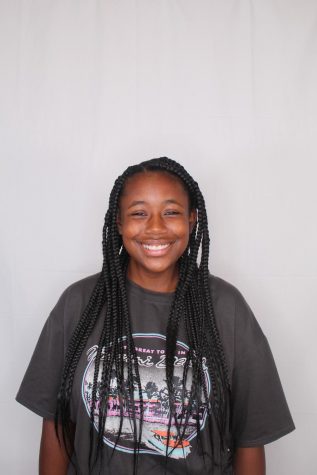
Erica Fields is senior Photo Editor for On the Record. She has a passion for telling comprehensive and compelling stories through photography and dreams...


